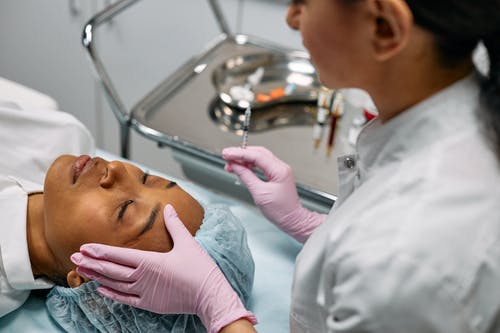Dermal fillers, also known as cheek and lip fillers, are injectable substances used to fill in minor facial lines and wrinkles that don’t respond well to other procedures like Botox. Dermal fillers can be produced from hyaluronic acid (HA), which occurs naturally in the human body, or from synthetic materials that have been approved by the Medicines and Healthcare Products Regulatory Agency of the United Kingdom. Depending on the type of lip filler used, this procedure can take anywhere from 15 minutes to an hour and a half, with results lasting up to one year after treatment.
Learn More About Dermal Fillers
Dermal fillers are a recent innovation in cosmetic surgery. Though they’ve been around for a while, they only recently became popular thanks to improvements in their safety profile. In short, dermal fillers can help improve your skin by plumping it up and smoothing out wrinkles and fine lines. Learn more about them here.
The Science Behind Filler Injections
Dermal fillers work by increasing volume to facial structures, restoring volume to cheeks that have lost fat, or building up a deflated look around eyes. Many fillers contain hyaluronic acid, which is an organic compound that naturally occurs in human tissue. As we age, our skin loses part of its own natural hyaluronic acid and begins to lose volume. Filler injections can help your skin regain its plumpness over time.
Why Take the Risk?
No one wants to look like they have multiple chins or small lips. Dermal fillers are an easy and painless way to make your face appear slimmer, fuller, or more youthful. However, there is a risk of hyperpigmentation or swelling that some people may not want to take. If you’re considering dermal fillers for yourself, here’s what you need to know about them before committing to a procedure.
How Safe are Fillers?
Cosmetic fillers like Restylane, Juvederm, Sculptra, Radiesse are made of naturally occurring products. You might have heard rumours about people getting sick or having negative reactions to these injectables—but for most people, these procedures are safe and effective at smoothing out lines, adding volume to lips, or filling out a flat cheekbone. Before deciding on a particular filler treatment, make sure your dermatologist has plenty of experience using it.
The Procedure Explained
Dermal fillers, also known as soft-tissue fillers, are injectable that helps plump up or smooth away facial lines. These include laugh lines around your mouth, furrows in your forehead, and frown lines across your brow. Dermal fillers have been popular for over 15 years, so they’re relatively safe—but don’t take that to mean they’re risk-free. If you do get them done, here are some things you should know.
Things to Consider before a Filler Injection
There are some issues to consider before getting a dermal filler injection. First, what type of injectable will you be receiving? Second, how long does each injection last? And third, how much does it cost? Below are answers to these questions to make an informed decision.
Aftercare Advice
Your aesthetician can provide you with aftercare instructions when they finish injecting your skin. However, most dermal fillers require little to no special attention afterward. Apply a gentle moisturiser to help keep your skin hydrated and massage it gently to aid in absorption. As a rule, avoid exercise or excessive heat exposure immediately following treatment. This will help minimize bruising or swelling during recovery time, typically 24-48 hours for most fillers.

